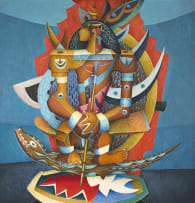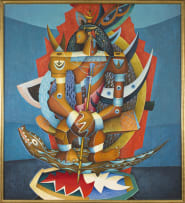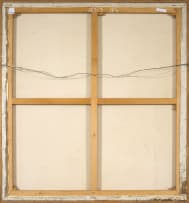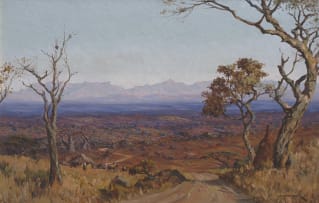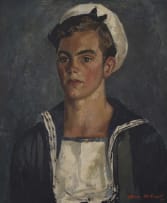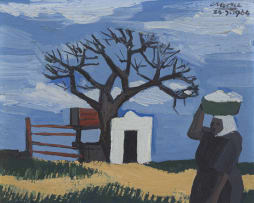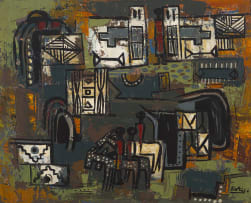Modern, Post-War and Contemporary Art, Decorative Arts and Jewellery
Live Virtual Auction, 11 - 12 October 2021
Modern and Post-War Art
Incl. Buyer's Premium & VAT
About this Item
signed and dated '64/5
Notes
Conceived on a mural-like scale, Boy with a Crocodile is a dazzling and heart-stopping mix of symbol, blazing colour and surprising pattern. Executed in the mid-1960s during a period of mature experimentation, particularly along purely abstract lines, the painting hints at the wide range of Preller's visual sources, his unique interpretations of African mythologies, and his irrepressible, richly-coloured imagination. The painting was first exhibited at the Lidchi Gallery in Johannesburg in the summer of 1965, alongside other landmark works such as In the Beginning, Temple of the Sun, Solomon and the Queen of Sheba I, The Gold Temple, Royal Stele and the 1965 version of Primavera (figure 1).
The composition is dominated by a heraldic figure - a stylised and virile princeling of sorts - wooden in body, still, with a mango-shaped head shown in profile, pouting lips, and an elaborately patterned headpiece. Clutching a staff, a highborn accessory, and with a sash across his chest, the boy stands, in some control, on a carved crocodile. The reptile, a sacred and totemic animal in so many southern African cultures, is here simplified in form, toothless, and with scales reduced to silvery blue triangles and crescents. Seemingly enthroned, the boy is surrounded by a hard-edged expanse of electric orange, and framed by flat, concentric discs. These asymmetrical and mandorla-like devices cause wonderful, decorative confusion: they enclose sections of lavender and mauve overpainted with flashes of blue and purple.
Boy with a Crocodile was first acquired by Dr Cyril Ross of Pretoria. Writing about the painting to its new owner in April 1968, Preller made it clear that the work was part of his evolving visual language: 'the various motifs and decorative elements derive from much of my earlier work, the origin of which is always Africa'. Indeed, the painting brings to mind so many of the artist's celebrated pictures, his iconic symbols, ornamental flourishes, cultural quotations and artistic allusions. The very subject of the painting, for instance, the boy himself, is the visual descendent of the Woman with a Lyre (1956), while the figure's tabletop shoulders owe something to the sculpture of the Dogon and Luba cultures that inspired Garden of Eden (1954) and In the Beginning (1962). The boy's circular 'fish-eye', moreover, can be traced back to Fetish Enthralled (1945), via such diverse paintings as The Gateway (1949) and Mozartian Fish (1952). Other decorative details, although strikingly reworked, conjure previous sources: the tight bracelets on the arms and ankles make reference to the artist's enchanting Mapogga series, while the scything, horn-shaped forms appearing at the figure's sides recall the bold patterning on the Swazi cloths Preller started collecting as far back as 1937.
Interestingly, a variation of Boy with a Crocodile (figure 2), completed in 1964 in shades of brown, mustard, olive and blue, was shown that year on the Exhibition of International Art at the New York World Fair. The painting, along with examples by Bettie Cilliers-Barnard and Jean Welz, disappeared shortly thereafter, only to re-surface in Cape Town in 2007.
The present lot has been selected by the curator Karel Nel for an upcoming exhibition of the artist at the Norval Foundation in 2023/24.
Exhibited
Lidchi Gallery, Johannesburg, Alexis Preller, 20 October to 8 November 1965, catalogue number 19.
Pretoria Art Museum, Alexis Preller Retrospective, Pretoria, 1972, catalogue number 116 (listed as Boy on a Crocodile).
Standard Bank Gallery, Johannesburg, Alexis Preller: Africa, The Sun and Shadows, 13 October to 5 December 2009.
Literature
Esmé Berman and Karel Nel (2009) Africa, the Sun and Shadows, Johannesburg: Shelf Publishing, illustrated on pages 244 and 245.
Esmé Berman and Karel Nel (2009) Collected Images, Johannesburg: Shelf Publishing, illustrated on pages 212-215.
Die Burger, Kuns, 4 January 2010, illustrated.

